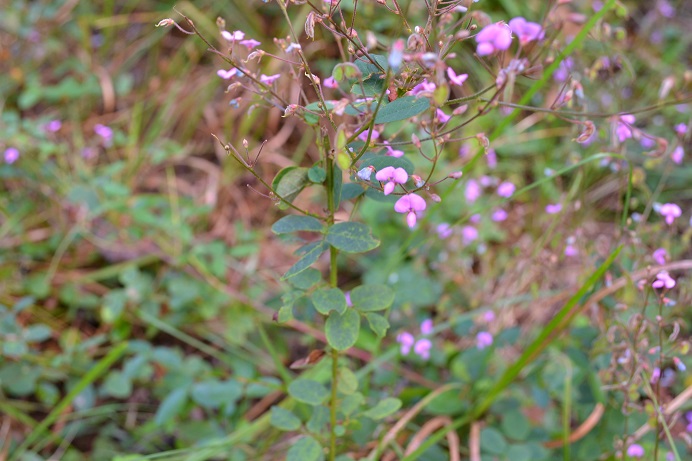Difference between revisions of "Desmodium ciliare"
(→Ecology) |
(→Taxonomic Notes) |
||
| Line 22: | Line 22: | ||
Varieties: none | Varieties: none | ||
| + | |||
| + | The genus name ''Desmodium'' derives from the Greek meaning of "long branch or chain".<ref name= "fact"/> | ||
==Description== | ==Description== | ||
Revision as of 16:56, 25 April 2019
Common name: Hairy Small-leaf Ticktrefoil [1]
| Desmodium ciliare | |
|---|---|

| |
| Photo by | |
| Scientific classification | |
| Kingdom: | Plantae |
| Division: | Magnoliophyta - Flowering plants |
| Class: | Magnoliopsida - Dicots |
| Order: | Fabales |
| Family: | Fabaceae |
| Genus: | Desmodium |
| Species: | D. ciliare |
| Binomial name | |
| Desmodium ciliare Muhl | |

| |
| Natural range of Desmodium ciliare from USDA NRCS Plants Database. | |
Contents
Taxonomic Notes
Synonyms: D. ciliare (Muhlenberg ex Willdenow) A.P. de Candolle var. ciliare; D. ciliare (Muhlenberg ex Willdenow) A.P. de Candolle var. lancifolium Fernald; Meibomia ciliaris (Muhlenberg ex Willdenow) Blake
Varieties: none
The genus name Desmodium derives from the Greek meaning of "long branch or chain".[2]
Description
D. ciliare is a perennial forb/herb of the Fabaceae family native to North America and Canada. [1] Leaves alternate, pinnately trifoliolate compound; leaflets usually 3, usually ovate-oblong or elliptic, larger ones usually less than 1.2 inches long, slightly rough to touch, stipels present; fruit is 1-3 jointed loment, margins densely covered with short, hooked hairs, surfaces moderately so. [3]
Distribution
D. ciliare can be found along the southeastern coast of the United States from Texas to Massachusetts, as well as the Ontario region of Canada.[1] It is also native to Cuba.[4]
Ecology
Habitat
D. ciliare is found in fields, woodland borders, and disturbed areas. [4] It also tends to be found in moister areas. [5] It prefers slightly acidic to neutral soil and medium- to fine-textured soil in partial shade.[2]
Phenology
D. ciliare has been observed to flower between September and November. [6] Otherwise, it generally flowers from June to September and fruits August to October.[4]
Seed dispersal
This species is thought to be dispersed by translocation on animal fur or feathers. [7]
Pollination
D. ciliare is pollinated by various members of bees in the Hymenoptera family including Bombus impatiens, Bombus pennsylvanicus, Megachile brevis brevis, Megachile mendica, Megachile petulans, Melissodes bimaculata bimaculata, Nomia nortoni nortoni, and Calliopsis andreniformis.[2]
Use by animals
It attracts birds and is a good plant for livestock grazing and browsing. The following caterpillars forage on the leaves: Hoary Edge (Achalarus lyciades), SilverSpotted Skipper (Epargyreus clarus), Southern Cloudywing (Thorybes bathyllus), Northern Cloudywing (Thorybes pylades), and caterpillars of the Eastern Tailed Blue (Everes comyntas) butterfly. The caterpillar of the Gray Hairstreak (Strymon melinus) butterfly feed on the flowers and developing seedpods. Other foragers include various beetles, some thirps, moth caterpillars, aphids, and stinkbugs. The seeds are eaten by bobwhite quail, turkey, white-footed mouse,and deer mouse while the foliage is eaten by larger animals including white-tailed deer and other hoofed mammal herbivores, and the cottontail rabbit. Historically, the roots were utilized the the Houma Native American tribe in Louisiana as an infusion with whiskey for treatment of weakness and cramps.[2]
Conservation and Management
D. ciliare is listed as threatened by the New York Department of Environmental Conservation Division of Land and Forests, and by the Rhode Island Department of Environmental Management. [1]
Cultivation and restoration
Photo Gallery
References and notes
- ↑ 1.0 1.1 1.2 1.3 USDA Plant Database https://plants.usda.gov/core/profile?symbol=DECI
- ↑ 2.0 2.1 2.2 2.3 Kirk, S. and Belt, S. 2010. Plant fact sheet for Hairy Small-Leaf Ticktrefoil (Desmodium ciliare), USDANatural Resources Conservation Service, Norman A. Bern National Plant Materials Center, Beltsville, 20705.
- ↑ Gee, K. L., et al. (1994). White-tailed deer: their foods and management in the cross timbers. Ardmore, OK, Samuel Roberts Noble Foundation.
- ↑ 4.0 4.1 4.2 Weakley, A. S. (2015). Flora of the Southern and Mid-Atlantic States. Chapel Hill, NC, University of North Carolina Herbarium.
- ↑ URL: http://herbarium.bio.fsu.edu. Last accessed: June 2018. Collectors: R.K. Godfrey, Loran C. Anderson, V. Sullivan, J. Wooten, R. Kral, J.P. Gillespie, Andre F. Clewell, Travis MacClendon, Karen MacClendon, Bill Boothe, A.C. Matthews, C. Ritchie Bell, John W. Thieret, G.W. Parmelee, Delzie Demaree, Edward S. Steele, A.P. Anderson, Sidney McDaniel, Joel A. Barnes, Steve Cox, States and counties: Leon County Florida, Franklin County Florida, Dade County Florida, Jackson County Florida, Wakulla County Florida, Madison County Florida, Liberty County Florida, Nassau County Florida, Jefferson County Florida, Thomas County Georgia, Calhoun County Florida, Orange County North Carolina, Spartanburg County South Carolina, Acadia County Louisiana, St. Joseph County Michigan, Drew County Arkansas, Dist. of Columbia, Macon County North Carolina, Oktibbeha County Mississippi, Grenada County Mississippi, Lamar County Mississippi, Grady County Georgia, Washington County Florida, Gadsden County Florida,
- ↑ Nelson, G. PanFlora: Plant data for the eastern United States with emphasis on the Southeastern Coastal Plains, Florida, and the Florida Panhandle. www.gilnelson.com/PanFlora/ Accessed: 21 MAY 2018
- ↑ Kirkman, L. Katherine. Unpublished database of seed dispersal mode of plants found in Coastal Plain longleaf pine-grasslands of the Jones Ecological Research Center, Georgia.